La part des femmes
Héla Fattoumi and Éric Lamoureux, choreographers and directors of VIADANSE, Centre chorégraphique national de Bourgogne-Franche-Comté in Belfort, have always placed the question of gender at the heart of their artistic journey, fueled by the desire to deconstruct the cogs of domination.
This exhibition is based on the book La Part des femmes (Nouvelles Éditions Place, 2021), which stems from the encounter, in 2012, between French researcher Anne Pellus (lecturer at the University of Toulouse 2 Jean-Jaurès) and the choreographers.
It invites the viewer to take a look at five emblematic pieces by Héla Fattoumi and Éric Lamoureux, created between 1998 and 2018 : Wasla-solo and Bnett Wasla, Manta, Lost in Burqa, Masculines. The photographs are signed Laurent Philippe and Maitetxu Etcheverria.
The journey of Héla Fattoumi and Éric Lamoureux’s artistic tandem is rooted in duality and otherness, which are reflected in the permanent dialogue between two perspectives, two singular imaginations, embodied by two individuals of different origins, cultures and genders.
Their aesthetic is thus politically situated in this logic of exchange, of welcoming the other, in a desire to create relationships. The links between the Norths and the Souths, as well as the visibility of the bodies concerned occupy an essential place in their approach.
They refuse that there is only one way to be a woman. Since female identity is a built concept, this process undergoes perpetual changes, and it is in this evolution that it multiplies in its incarnation and blurs the biological imprint of the bodies.
La part des femmes, performance
Created especially for Chaillot Théâtre National de la Danse, this performance resonates like an echo of the work : La part des femmes by Anne Pellus.
La part des femmes, une traversée chorégraphique
Combining gesture, story and video, this dance performance offers a hybrid format between choreographic “re-visitations”, archive images and the story-testimony of Héla Fattoumi surrounded by two performers : Meriem Bouajaja and Chourouk El Mahati.
Wasla-solo and Bnett Wasla
In the beginning was Wasla-solo, which I like to translate as "the solo that connects". It is for me a kind of return to my native land through dance.
The project was simple : cross through the old town, the medina of Tunis, daily (...) In the palace of Halfaouine, we were taken to the dance studio with its barres, its mirrors. But I was drawn to the hall of the alcoves ; particularly one of them, into which I immediately curled up… I opened my arms… Incredibly, I fitted into it perfectly, it looked as if it was waiting for me.
It was the alcove that started it all, the construction of a performance around the multiple attempts at empowerment. It had become a cozy nest, a golden cage, a kind of mother's womb. - Héla Fattoumi
Wasla (ce qui relie) [Solo]
1998 - Director : Picq, Charles
Choreographer(s) : Fattoumi, Héla (Tunisia) Lamoureux, Éric (France)
Bnett Wasla is a rewrite of Wasla-solo. It was recreated with four dancers from the Ballet and Choreographic Arts Department of the Cité de la Culture in Tunis.
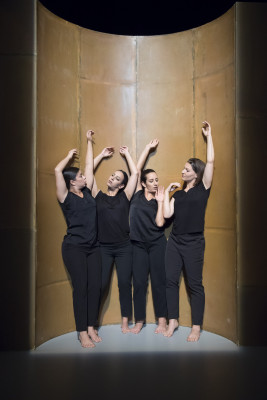
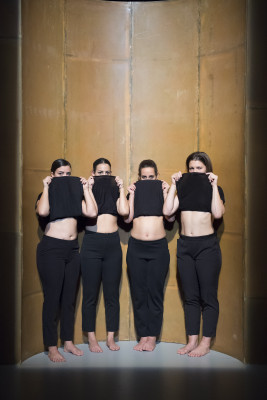
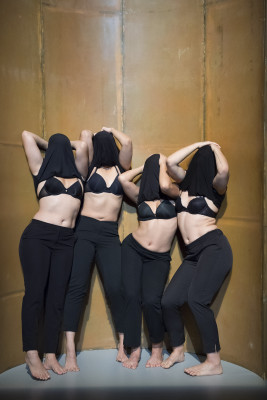
The solo becomes a quartet through this transmission, also signifying the passage from the intimate to the collective. Using the same alcove as in Wasla-solo, Bnett Wasla is the story of an emancipation where the female bodies first linked to the womb, heads riveted to the stone walls, escape and gradually expand.
Bnett Wasla (2018)
[extrait]
2018 - Director : Lamoureux, Éric
Choreographer(s) : Fattoumi, Héla (Tunisia) Lamoureux, Éric (France)
It was the four dancers of the Tunis Opera Ballet who made me want to embark on this adventure of transmission ; I felt it was the right time and that it would be with them. I loved our discussions, I told them about the Wasla issues of my time and they told me about their commitment as women, artists, dancers in a post-revolutionary Muslim country.
Bnett Wasla, which literally means "the girls of Wasla", has become a kind of feminist manifesto carried by these formidable performers Nour, Oumaima, Houda and Cyrinne - Héla Fattoumi
Manta and Lost in burqa
Manta is a solo performed by Héla Fattoumi wearing the niqab, a full veil. This garment which can be related to many controversies, is a creative trigger for the two choreographers. Dancing with a veil, shaking its drape, discovering its resistance, its transparency, is to give rise to powerful images that strike our imagination.


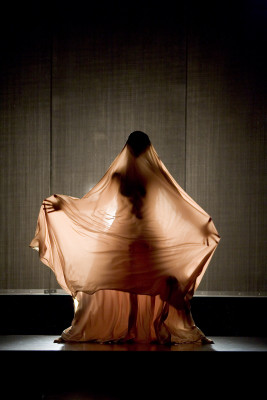
Born in Tunisia, Héla Fattoumi saw the women of her childhood gradually abandon the safsari, a white and elegant veil linked more to tradition than to religion. The introduction of the full veil and the religious and political claims associated with it are a challenging issue to her.
Manta is a dance piece bordering on the art of performance. It is in her name and in her body as a dancer that Héla Fattoumi explores her relationship to the veil and thus takes a stand.
The initial shock was in 2006, in Syria, we were on tour… I remember precisely, in the city of Aleppo, this fortuitous encounter.
I found myself opposite someone dressed in black with her face almost fully covered. It was a woman holding a little boy by the hand, a gloved hand.
All that remained was the gaze, the only opening to the outside which lets the inside enter towards the infinitesimal and the intimate.
I remember the sensations, in the rehearsal studio, slipping inside the fabric, feeling its weight on the head, on the shoulders, I sketched gestures, I ventured into postures, and I entered into a time without measure, an infinite tension, an experience in apnea. - Héla Fattoumi
Lost in burqa began with the encounter between Héla Fattoumi and Éric Lamoureux and the Moroccan visual artist, Majida Khattari, who has won renown for her fashion shows featuring “clothing-sculptures” inspired by burqas, niqabs and other safsaris. Through these performances, she denounces the confinement of the body and questions the complex and ambiguous situation of women in contemporary Islam.
This piece brings together a mixed cast of male and female dancers. The eight performers appropriate these sculptures of moving fabrics, guided by the imaginary potential of each of them, in a disturbing and surprising dance. Lost in Burqa questions the symbolic and fantastical effects of the hijab, this sometimes imposed garment, the primary nature of which would be "to conceal from view or to isolate a body or an object".
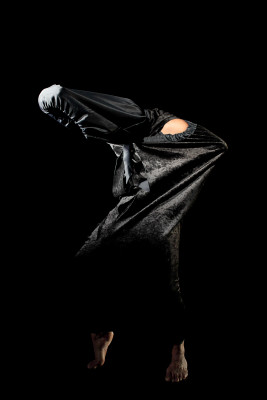
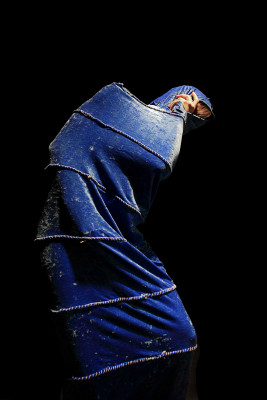
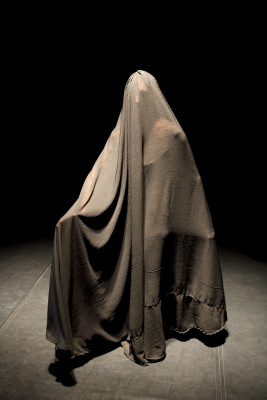
After Manta, we asked other performers to share this experience of invisibility, of the disappearance of the body under a veil, this physical experience of the fabric, of its weight, of the slowness it imposes ; inhabit and bring to life these burqas in their great diversity in terms of their textures, shapes, materials and lengths in order to bring out images, with subversive tones of images that open up the imagination. - Héla Fattoumi
Lost in Burqa (2011)
[extrait]
Masculines
Seven dancers in search of emancipation perform the stereotypes of femininity : languid dancers from the Bain turc of Ingres, silent Moors from Orientalist postcards, dolls with hair and nail extensions and enhanced with high-heeled shoes...

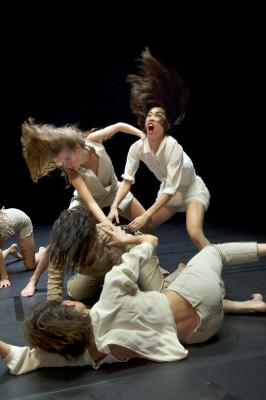

The stage here is a battlefield where clichés are embodied. It makes them waver and deconstructs norms that patriarchy invites us to consider as innate and essential to our identities, and that each person has had the opportunity not only to internalize but also to incorporate.
Masculines (2013)
[extrait]
Powerful and rebellious, they stare down and demolish the clichés towards a freedom of body without measure.
The Turkish bath of Ingres no longer has an outline, there is no longer either masculine or feminine: there is only vital and collective energy. - Héla Fattoumi
_________________________
This selection of photos is taken from the book La Part des femmes published by Nouvelles Éditions Place (2021).
Anne Pellus (Lecturer at the University of Toulouse 2 Jean-Jaurès) reveals how, through dancing bodies, each work echoes our world and our history. It is based on five pieces by Héla Fattoumi and Eric Lamoureux, whom she met in 2012, and whose work she has since followed.
Books can be ordered on the ‘Books on the move’ website.